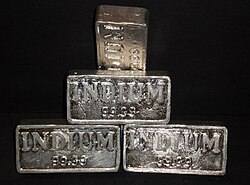Indium
Indium's current primary application is to form transparent electrodes from indium tin oxide (ITO) in liquid crystal displays and touchscreens, and this use largely determines its global mining production. It is widely used in thin-films to form lubricated layers (during World War II it was widely used to coat bearings in high-performance aircraft). It is also used for making particularly low melting point alloys, and is a component in some lead-free solders.
Indium is not known to be used by any organism. In a similar way to aluminium salts, indium(III) ions can be toxic to the kidney when given by injection, but oral indium compounds do not have the chronic toxicity of salts of heavy metals, probably due to poor absorption in basic conditions. Radioactive indium-111 (in very small amounts on a chemical basis) is used in nuclear medicine tests, as a radiotracer to follow the movement of labeled proteins and white blood cells in the body.
Creation and occurrence
Indium is created via the long-lasting, (up to thousands of years), s-process in low-medium mass stars (which range in mass between 0.6 and 10 masses of Sun). When a silver-109 atom, which comprises approximately half of all silver in existence, catches a neutron, it undergoes a beta decay to become cadmium-110. Capturing further neutrons, it becomes cadmium-115, which decays to indium-115 via another beta decay. This explains why the radioactive isotope predominates in abundance compared to the stable one.
Indium is 61st most abundant element in the Earth's crust at approximately 49 ppb, making indium approximately as abundant as mercury. Fewer than 10 indium minerals are known, such as dzhalindite (In(OH)3) and indite (FeIn2S4), but none of these occurs in significant deposits.
Based on content of indium in zinc ore stocks, there is a worldwide reserve base of approximately 6,000 tonnes of economically viable indium. However, the Indium Corporation, the largest processor of indium, claims that, on the basis of increasing recovery yields during extraction, recovery from a wider range of base metals (including tin, copper and other polymetallic deposits) and new mining investments, the long-term supply of indium is sustainable, reliable and sufficient to meet increasing future demands.
This conclusion may be reasonable considering that silver, which is one-third as abundant as indium in the Earth's crust, is currently mined at approximately 18,300 tonnes per year, which is 40 times greater than current indium mining rates.
| Symbol | In | |
| Atomic Number | 49 | |
| Atomic Weight | 114.818 | |
| Oxidation States | +3 | |
| Electronegativity, Pauling | 1.78 | |
| State at RT | Solid, Metal | |
| Melting Point, K | 429.32 | |
| Boiling Point, K | 2353 |
Appearance and Characteristics
Harmful effects:
Indium is considered to be of low toxicity.
Characteristics:
- Indium is a very soft, silvery-white lustrous metal.
- Indium liquid clings to or wets glass and similar surfaces.
- Like gallium, indium remains in a liquid state over a wide range of temperatures.
- When present in compounds, indium exists mostly in the oxidation state III.
- When heated above its melting point, it burns with a violet flame to the yellow sesquioxide (In2O3).
Uses of Indium
- Indium is used in the production of low-melting alloys, typically with gallium.
- The melting point depends on the ratio of indium to gallium.
- An alloy with 24% indium and 76% gallium, for example, melts at just 16 oC. (4)
- This type of alloy can be used as a non-toxic alternative to mercury in some applications.
- Compounds of indium are used in the semiconductor industry for germanium transistors, thermistors, rectifiers and photocells.
- Indium can be coated on metals and evaporated onto glass, to form mirrors equal to that made with silver but more corrosion resistant.
- Indium-tin oxide thin films are used for liquid crystal displays (LCDs).
